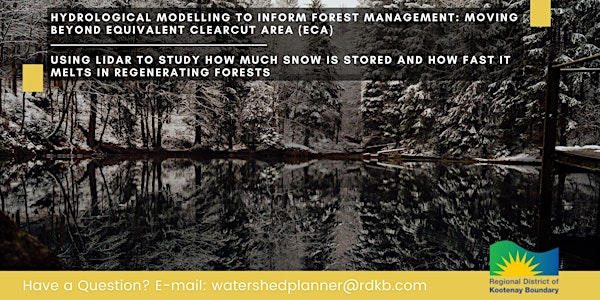

Hydrological Model Informing Forestry Plans: Beyond ECA; & Snow Impacts
Hear about a new tool informing hydrological impacts before forest management decisions, and how snow levels change as forests regenerate.
Date and time
Location
Selkirk College - Grand Forks Campus
486 72nd Avenue Grand Forks, BC V0H 1H0 CanadaAbout this event
- 1 hour 30 minutes
Hydrological Modelling to Inform Forest Management: Moving Beyond Equivalent Clearcut Area (ECA) & Using LiDAR to study peak snow water storage and melt rates in recovering forest stands
Join us as we delve into the world of hydrological modelling and its role in shaping forest management practices. Learn how we can move beyond Equivalent Clearcut Area (ECA) to improve watershed process understanding and make more informed management decision. Followed by a presentation on using LiDAR to measure snow volume and melt rates in regenerating forests, and how vegetation age, type and landscape all affect watershed hydrology. This in-person event will be held at Selkirk College - Grand Forks Campus, so mark your calendars!
Both presenters undertake research activities through Selkirk Innovates and are consulting geoscientists with Apex Geoscience Consultants (Nelson, BC). Dr. Kim Green, Co-Founder and senior geoscientist, has worked in the field of watershed science for over 25 years with a focus on hydrology, fluvial geomorphology and geology. Cydne Potter is a geospatial analyst, currently completing her MSc in LiDAR based investigation of hydrological recovery in mountainous regions.
Detailed Description of presentations:
K. Green. Hydrological Modelling to Inform Forest Management: Moving Beyond Equivalent Clearcut Area (ECA). Forest disturbance can alter the hydrologic conditions of a watershed, including the frequency, magnitude, and timing of peak and low flows. Equivalent Clearcut Area (ECA) has been routinely used in watershed assessments to estimate hydrologic change due to forest disturbance. ECA analyses typically rely on broad regional assumptions, qualitative observations, and/or expert judgement, making it difficult to provide accurate measurable estimates of hydrologic change. Process-based hydrological models offer an improved approach as they combine watershed processes, land cover and climate change into the evaluation; providing quantitative estimates of hydrologic change, including at ungauged points of interest. An example using a hydrological model to investigate forest disturbance and future climate change scenarios is demonstrated. Results are contrasted with ECA-based outputs and emphasize that in addition to the amount of forest disturbance, watershed physical characteristics and the location of disturbance within a watershed influence the hydrologic response. This approach provides forest managers with quantitative outputs that support risk-based forest management decisions and presents a substantial improvement over ECA-based methods. Dr. Green will talk about this new approach, focusing on how it's use in the Kettle River Basin.
C. Potter. Using LiDAR to study peak snow water storage and melt rates in recovering forest stands. Forests affect streamflow magnitude and timing in snow-dominated watersheds by moderating peak annual snow water storage and the timing and rate of snow melt. This two-year study uses handheld LiDAR surveys of below-canopy snowpack to measure the processes by which regenerating forest stands affect watershed hydrology. This talk highlights what we have learned about the roles of vegetation and aspect on the hydrological recovery of the stand and how this might improve our understanding of watershed-scale processes.